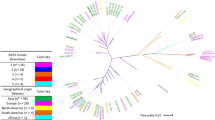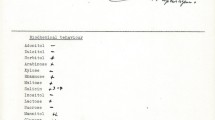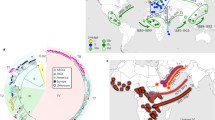Abstract
The theory that Shigella is derived from multiple independent origins of Escherichia coli (Pupo et al. 2000) has been challenged by recent findings that the virulence plasmids (VPs) and the chromosomes share a similar evolutionary history (Escobar-Paramo et al. 2003), which suggests that an ancestral VP entered an E. coli strain only once, which gave rise to Shigella spp. In an attempt to resolve these conflicting theories, we constructed three phylogenetic trees in this study: a robust chromosomal tree using 23 housekeeping genes from 46 strains of Shigella and enteroinvasive E. coli (EIEC), a chromosomal tree using 4 housekeeping genes from 19 EcoR strains and 46 Shigella/EIEC strains, and a VP tree using 5 genes outside of the VP cell-entry region from 38 Shigella/EIEC strains. Both chromosomal trees group Shigella into three main clusters and five outliers, and strongly suggest that Shigella has multiple origins within E. coli. Most strikingly, the VP tree shows that the VPs from two main Shigella clusters, C1 and C2, are more closely related, which contradicts the chromosomal trees that place C2 and C3 next to each other but C1 at a distance. Additionally, we have identified a complete tra operon of the F-plasmid in the genome sequence of an EIEC strain and found that two other EIEC strains are also likely to possess a complete tra operon. All lines of evidence support an alternative multiorigin theory that transferable diverse ancestral VPs entered diverse origins of E. coli multiple times during a prolonged period of time, resulting in Shigella species with diverse genomes but similar pathogenic properties.



Similar content being viewed by others
References
Blocker A, Gounon P, Larquet E, Niebuhr K, Cabiaux V, Parsot C, Sansonetti P (1999) The tripartite type III secreton of Shigella flexneri inserts IpaB and IpaC into host membranes. J Cell Biol 147:683–693
Buchrieser C, Glaser P, Rusniok C, Nedjari H, D’Hauteville H, Kunst F, Sansonetti P, Parsot C (2000) The virulence plasmid pWR100 and the repertoire of proteins secreted by the type III secretion apparatus of Shigella flexneri. Mol Microbiol 38:760–771
Clermont O, Bonacorsi S, Bingen E (2000) Rapid and simple determination of the Escherichia coli phylogenetic group. Appl Environ Microbiol 66:4555–4558
Escobar-Paramo P, Clermont O, Blanc-Potard AB, Bui H, Le Bouguenec C, Denamur E (2004) A specific genetic background is required for acquisition and expression of virulence factors in Escherichia coli. Mol Biol Evol 21:1085–1094
Escobar-Paramo P, Giudicelli C, Parsot C, Denamur E (2003) The evolutionary history of Shigella and enteroinvasive Escherichia coli revised. J Mol Evol 57:140–148
Frost LS, Ippen-Ihler K, Skurray RA (1994) Analysis of the sequence and gene products of the transfer region of the F sex factor. Microbiol Rev 58:162–210
Hale TL (1991) Genetic basis of virulence in Shigella species. Microbiol Rev 55:206–224
Hyma KE, Lacher DW, Nelson AM, Bumbaugh AC, Janda JM, Strockbine NA, Young VB, Whittam TS (2005) Evolutionary genetics of a new pathogenic Escherichia species: Escherichia albertii and related Shigella boydii strains. J Bacteriol 187:619–628
Jin Q, Yuan Z, Xu J, Wang Y, Shen Y, Lu W, Wang J, Liu H, Yang J, Yang F, Zhang X, Zhang J, Yang G, Wu H, Qu D, Dong J, Sun L, Xue Y, Zhao A, Gao Y, Zhu J, Kan B, Ding K, Chen S, Cheng H, Yao Z, He B, Chen R, Ma D, Qiang B, Wen Y, Hou Y, Yu J (2002) Genome sequence of Shigella flexneri 2a: insights into pathogenicity through comparison with genomes of Escherichia coli K12 and O157. Nucleic Acids Res 30:4432–4441
Kotloff KL, Winickoff JP, Ivanoff B, Clemens JD, Swerdlow DL, Sansonetti PJ, Adak GK, Levine MM (1999) Global burden of Shigella infections: implications for vaccine development and implementation of control strategies. Bull WHO 77:651–666
Kumar S, Tamura K, Nei M (2004) MEGA3: integrated software for Molecular Evolutionary Genetics Analysis and sequence alignment. Brief Bioinform 5:150–163
Lan R, Reeves PR (2002) Escherichia coli in disguise: molecular origins of Shigella. Microbes Infect 4:1125–1132
Lan R, Lumb B, Ryan D, Reeves PR (2001) Molecular evolution of large virulence plasmid in Shigella clones and enteroinvasive Escherichia coli. Infect Immun 69:6303–6309
Lan R, Alles MC, Donohoe K, Martinez MB, Reeves PR (2004) Molecular evolutionary relationships of enteroinvasive Escherichia coli and Shigella spp. Infect Immun 72:5080–5088
Maneewannakul S, Kathir P, Ippen-Ihler K (1992) Characterization of the F plasmid mating aggregation gene traN and of a new F transfer region locus trbE. J Mol Biol 225:299–311
Pupo GM, Lan R, Reeves PR (2000) Multiple independent origins of Shigella clones of Escherichia coli and convergent evolution of many of their characteristics. Proc Natl Acad Sci USA 97:10567–10572
Rokas A, Williams BL, King N, Carroll SB (2003) Genome-scale approaches to resolving incongruence in molecular phylogenies. Nature 425:798–804
Sansonetti PJ, Kopecko DJ, Formal SB (1982) Involvement of a plasmid in the invasive ability of Shigella flexneri. Infect Immun 35:852–860
Schandel KA, Maneewannakul S, Ippen-Ihler K, Webster RE (1987) A traC mutant that retains sensitivity to f1 bacteriophage but lacks F pili. J Bacteriol 169:3151–3159
Souza V, Eguiarte LE (1997) Bacteria gone native vs. bacteria gone awry? Plasmidic transfer and bacterial evolution. Proc Natl Acad Sci USA 94:5501–5503
Thompson JD, Higgins DG, Gibson TJ (1994) CLUSTAL W: improving the sensitivity of progressive multiple sequence alignment through sequence weighting, position-specific gap penalties and weight matrix choice. Nucleic Acids Res 22:4673–4680
Tominaga A, Lan R, Reeves PR (2005) Evolutionary changes of the flhDC flagellar master operon in Shigella strains. J Bacteriol 187:4295–4302
Traxler BA, Minkley EG, Jr. (1988) Evidence that DNA helicase I and oriT site-specific nicking are both functions of the F TraI protein. J Mol Biol 204:205–209
Venkatesan MM, Goldberg MB, Rose DJ, Grotbeck EJ, Burland V, Blattner FR (2001) Complete DNA sequence and analysis of the large virulence plasmid of Shigella flexneri. Infect Immun 69:3271–3285
Wei J, Goldberg MB, Burland V, Venkatesan MM, Deng W, Fournier G, Mayhew GF, Plunkett G III, Rose DJ, Darling A, Mau B, Perna NT, Payne SM, Runyen-Janecky LJ, Zhou S, Schwartz DC, Blattner FR (2003) Complete genome sequence and comparative genomics of Shigella flexneri serotype 2a strain 2457T. Infect Immun 71:2775–2786
Willetts N (1977) The transcriptional control of fertility in F-like plasmids. J Mol Biol 112:141–148
Yang F, Yang J, Zhang X, Chen L, Jiang Y, Yan Y, Tang X, Wang J, Xiong Z, Dong J, Xue Y, Zhu Y, Xu X, Sun L, Chen S, Nie H, Peng J, Xu J, Wang Y, Yuan Z, Wen Y, Yao Z, Shen Y, Qiang B, Hou Y, Yu J, Jin Q (2005) Genome dynamics and diversity of Shigella species, the etiologic agents of bacillary dysentery. Nucleic Acids Res 33:6445–6458
Yang J, Chen L, Yu J, Sun L, Jin Q (2006) ShiBASE: an integrated database for comparative genomics of Shigella. Nucleic Acids Res 34:D398–D401
Acknowledgments
We are grateful to Jianguo Xu (CCDC) and Lei Wang (NKU) for providing Shigella/EIEC strains. This work was supported by the State Key Basic Research Program (Grant No. 2005CB522904), a High Technology Project (Grant No. 2004AA223090) of the Ministry of Science and Technology of China, and a Beijing Science and Technology Project (Contract No. H010210360119).
Author information
Authors and Affiliations
Corresponding author
Additional information
[Reviewing Editor: Dr. Martin Kreitman]
Jian Yang and Huan Nie contributed equally to this work.
Electronic Supplementary Material
Rights and permissions
About this article
Cite this article
Yang, J., Nie, H., Chen, L. et al. Revisiting the Molecular Evolutionary History of Shigella spp.. J Mol Evol 64, 71–79 (2007). https://doi.org/10.1007/s00239-006-0052-8
Received:
Accepted:
Published:
Issue Date:
DOI: https://doi.org/10.1007/s00239-006-0052-8




